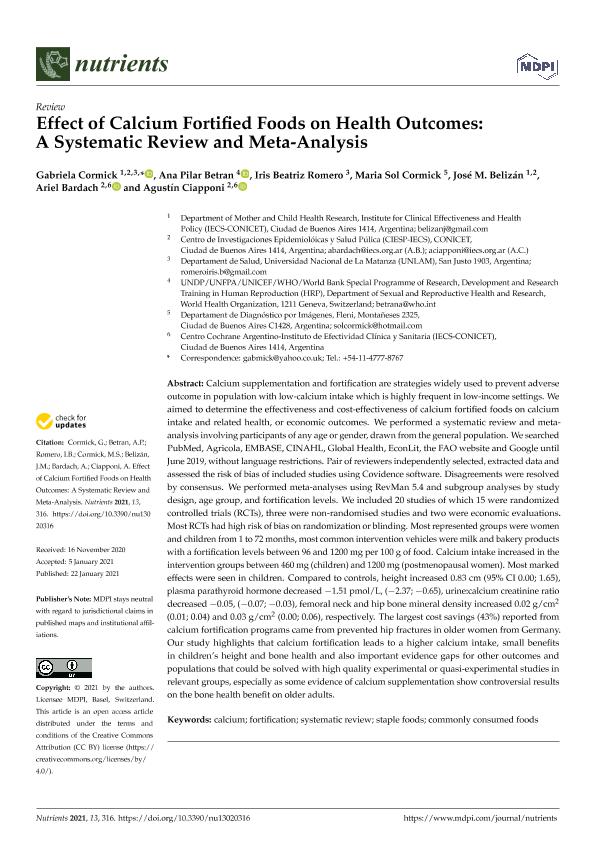Artículo
Effect of calcium fortified foods on health outcomes: A systematic review and meta-analysis
Cormick, Gabriela ; Betrán, Ana Pilar; Romero, Iris Beatriz; Cormick, María Sol; Belizan, Jose
; Betrán, Ana Pilar; Romero, Iris Beatriz; Cormick, María Sol; Belizan, Jose ; Bardach, Ariel Esteban
; Bardach, Ariel Esteban ; Ciapponi, Agustín
; Ciapponi, Agustín
 ; Betrán, Ana Pilar; Romero, Iris Beatriz; Cormick, María Sol; Belizan, Jose
; Betrán, Ana Pilar; Romero, Iris Beatriz; Cormick, María Sol; Belizan, Jose ; Bardach, Ariel Esteban
; Bardach, Ariel Esteban ; Ciapponi, Agustín
; Ciapponi, Agustín
Fecha de publicación:
02/2021
Editorial:
MDPI AG
Revista:
Nutrients
ISSN:
2072-6643
Idioma:
Inglés
Tipo de recurso:
Artículo publicado
Clasificación temática:
Resumen
Calcium supplementation and fortification are strategies widely used to prevent adverse outcome in population with low-calcium intake which is highly frequent in low-income settings. We aimed to determine the effectiveness and cost-effectiveness of calcium fortified foods on calcium intake and related health, or economic outcomes. We performed a systematic review and metaanalysis involving participants of any age or gender, drawn from the general population. We searched PubMed, Agricola, EMBASE, CINAHL, Global Health, EconLit, the FAO website and Google until June 2019, without language restrictions. Pair of reviewers independently selected, extracted data and assessed the risk of bias of included studies using Covidence software. Disagreements were resolved by consensus. We performed meta-analyses using RevMan 5.4 and subgroup analyses by study design, age group, and fortification levels. We included 20 studies of which 15 were randomized controlled trials (RCTs), three were non-randomised studies and two were economic evaluations. Most RCTs had high risk of bias on randomization or blinding. Most represented groups were women and children from 1 to 72 months, most common intervention vehicles were milk and bakery products with a fortification levels between 96 and 1200 mg per 100 g of food. Calcium intake increased in the intervention groups between 460 mg (children) and 1200 mg (postmenopausal women). Most marked effects were seen in children. Compared to controls, height increased 0.83 cm (95% CI 0.00; 1.65), plasma parathyroid hormone decreased −1.51 pmol/L, (−2.37; −0.65), urine:calcium creatinine ratio decreased −0.05, (−0.07; −0.03), femoral neck and hip bone mineral density increased 0.02 g/cm2 (0.01; 0.04) and 0.03 g/cm2 (0.00; 0.06), respectively. The largest cost savings (43%) reported from calcium fortification programs came from prevented hip fractures in older women from Germany. Our study highlights that calcium fortification leads to a higher calcium intake, small benefits in children’s height and bone health and also important evidence gaps for other outcomes and populations that could be solved with high quality experimental or quasiexperimental studies in relevant groups, especially as some evidence of calcium supplementation show controversial results on the bone health benefit on older adults.
Palabras clave:
CALCIUM
,
COMMONLY CONSUMED FOODS
,
FORTIFICATION
,
STAPLE FOODS
,
SYSTEMATIC REVIEW
Archivos asociados
Licencia
Identificadores
Colecciones
Articulos(CIESP)
Articulos de CENTRO DE INVESTIGACIONES EN EPIDEMIOLOGIA Y SALUD PUBLICA
Articulos de CENTRO DE INVESTIGACIONES EN EPIDEMIOLOGIA Y SALUD PUBLICA
Citación
Cormick, Gabriela; Betrán, Ana Pilar; Romero, Iris Beatriz; Cormick, María Sol; Belizan, Jose; et al.; Effect of calcium fortified foods on health outcomes: A systematic review and meta-analysis; MDPI AG; Nutrients; 13; 2; 2-2021; 1-31
Compartir
Altmétricas



